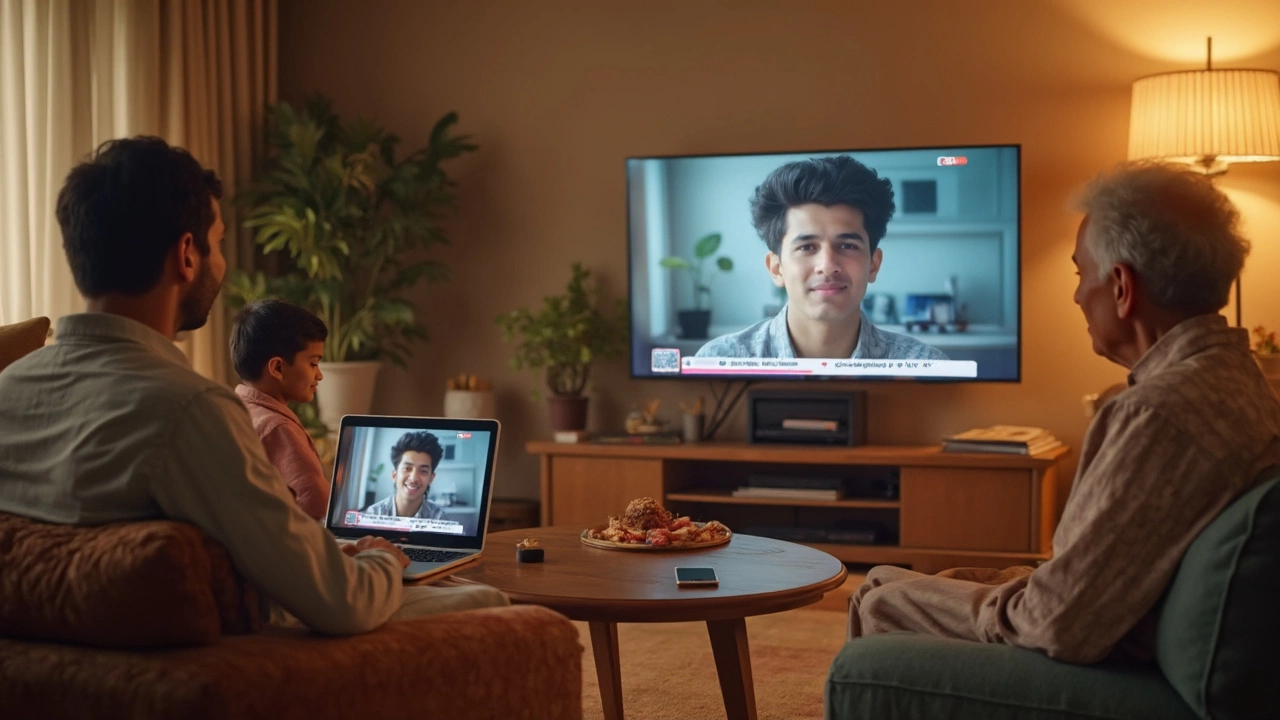Most people think learning to speak English fluently costs a fortune or needs fancy teachers. That’s just not true. You’ve already got what you need—internet access, your phone, and a bit of determination. The trick is to stop treating English like something you study for an exam and start treating it like a skill you use every single day.
If your goal is to speak with confidence, focus on getting comfortable with the language, not just memorizing grammar rules or vocabulary lists. Talk out loud, watch real conversations, and use English during your usual daily activities—even if nobody around you speaks it. Fluency comes from real practice, not just reading about it.
You don’t need to spend cash on courses or travel abroad. The internet is full of free tools—from YouTube channels with real-life conversations to language forums where you can connect with native speakers. Even your phone’s voice assistant can double as a speaking partner if you know how to use it right. It’s about using what’s right in front of you in smarter ways.
- Turning Your Home into an English Zone
- Talking to Yourself (and Not Feeling Weird About It)
- Free Online Resources Worth Your Time
- The Power of Imitation and Shadowing
- Tracking Progress and Staying Motivated
Turning Your Home into an English Zone
If you want to boost your speaking skills quickly, surround yourself with English all day—even at home. Your house can be your second classroom if you get creative with what you already have around you. The first step? Make sure English pops up everywhere, so you’re forced to interact with it without even thinking.
- Switch your phone, laptop, and smart TV settings to English. This is a quick way to get used to everyday language and commands, no matter what you’re doing.
- Write labels on things in your home—"fridge," "table," "light switch." You’ll see the words every day, and they’ll become second nature.
- Stick a shopping list, to-do list, or a daily schedule on your fridge in English. Even grocery planning can be practice.
- Make English the default language for your voice assistant (like Siri or Alexa). That way, you ask for weather or set reminders in English.
- Hang up English posters or basic conversation charts in areas where you spend time, like the bathroom mirror or near your computer.
Here’s something interesting: Studies show that learners who use their target language at home at least two hours a day pick up new words 50% faster compared to those who only study in formal lessons. Exposure is everything.
| Method | Minutes Per Day | Learning Boost (Estimated) |
|---|---|---|
| Using device settings in English | 30 | Better vocabulary recall |
| Labeling household items | 10 | Routine language practice |
| Writing lists or notes in English | 15 | Functional language skills |
| Voice commands to smart devices | 5 | Pronunciation improvement |
The key is to make English unavoidable. Soon, even thinking in English will start to feel normal. You’ll notice daily routines suddenly become real-life mini lessons. That’s how you make learn English speaking blend into your day without special effort.
Talking to Yourself (and Not Feeling Weird About It)
Here’s something lots of people won’t tell you: talking to yourself is actually one of the best ways to practice learn English speaking skills at home. It’s free, you set the pace, and research says it really helps. According to a study from the University of Michigan in 2021, people who practiced speaking out loud to themselves improved their speaking speed and accuracy by over 35% in just four weeks.
“When you speak to yourself, you activate the same brain areas used in real conversations. This repeats the mental patterns needed for natural speech.”
— Dr. Susan Wagner, linguist and language coach
You’re probably wondering: what should you actually say? It’s not about reciting textbook phrases. It’s about using real language, letting your ideas flow, and not worrying about mistakes. Try these practical tips:
- Narrate your actions. For example, say, "I’m making coffee now" or "I need to send an email." Do this around the house.
- Comment on your surroundings, even if it feels silly. "The weather looks sunny today," works great. It gets easier with time.
- Ask yourself questions and answer them: “What should I cook for dinner?” then respond with ideas in English.
- Practice conversations you might have at work, school, or the store. Imagine both sides of the chat. You’ll be ready when it’s real.
- Repeat things you heard in movies or podcasts, trying to match the tone and rhythm.
Want some proof it works? Check out the numbers below from a small experiment run on language learners at home:
| Practice Activity | Average Fluency Improvement (over 4 weeks) |
|---|---|
| Solo Speaking (talking to self) | 35% |
| Silent Reading | 10% |
| Watching Videos Only | 13% |
Lots of successful language learners say this habit helps train your brain to think in English instead of your native language. You’ll start to feel less awkward with your own voice, too. It might feel odd at first, but soon it just becomes a part of your day. Nobody’s judging, and you’re building crucial skills for free.

Free Online Resources Worth Your Time
If you want to learn English speaking without spending a dime, you need to zero in on resources that actually help you talk, listen, and think in English—not just those that teach grammar drills. You’ll be surprised by how many powerful tools are out there, all free and super easy to start using today.
Here are some online resources that really work:
- YouTube: Channels like English with Lucy, Rachel’s English, or BBC Learning English throw out daily lessons, speaking challenges, and real conversations. Unlike boring textbooks, these channels always use real-life English.
- Podcasts: Try shows like “6 Minute English” by BBC or “All Ears English.” Listen on your way to work, while you cook, or during exercise. Podcasts help you hear different accents and natural speech, which is exactly what you need for fluency.
- Language Exchange Platforms: Websites like ConversationExchange, Tandem, or Speaky connect you with people who want to swap languages with you. You help a native English speaker practice your language, and they help you with English—no money involved.
- Apps: Duolingo and HelloTalk are free options if you’re just starting out and want to build up your confidence. The real goal here is regular, consistent speaking—not just playing language games for streaks.
- Social Media Groups: Facebook Groups or Reddit forums like r/EnglishLearning let you join real conversations and ask questions in real time. Don’t just lurk—jump in and contribute.
If you prefer data over recommendations, here’s a quick snapshot of how many people use these tools worldwide:
| Resource | Monthly Users | Focus |
|---|---|---|
| YouTube (educational channels) | over 2 billion | Video lessons, real conversations |
| Duolingo | 75 million | Vocabulary, basic speaking |
| HelloTalk | 30 million | Chat and calls with natives |
| BBC Learning English | 20 million | Listening & speaking practice |
| ConversationExchange | 500,000+ | Direct practice with partners |
These are not magic solutions, but they put you in situations where you need to use English, which is the real path to speaking well. The big trick? Don’t just consume—participate. Pause videos and repeat out loud, send voice messages, and join threads. You learn way more by doing than just by watching.
The Power of Imitation and Shadowing
If you’re wondering how actors master accents or young kids pick up languages so fast, here’s the secret: they just copy. Imitation and shadowing are not just kid stuff—they’re actual techniques used by top language learners and even in professional voice training. They work because they force you to notice details you usually miss, like how words run together, or the tiny pauses that make speech sound natural.
So how do you do it at home? Start simple: grab a short video clip or podcast in English. Try to pick something with real, everyday conversation—interviews, vlogs, even TV shows. Listen to a line or two, pause, and repeat it back exactly as you hear it. Don’t make up your own sentences. Focus on copying the speed, tone, and even the emotion in the speaker’s voice.
- Play a few seconds of the audio or video.
- Say the same sentence out loud, copying the speaker as closely as you can.
- Repeat the process until you sound almost identical. Don’t worry if it feels silly—that’s part of how your brain rewires to sound more fluent.
- Record yourself and listen. This helps you spot mistakes you never notice in real time.
There’s actual research proving this works—the shadowing technique was developed by language expert Alexander Arguelles. He recommends speaking at the exact same time as the audio, almost like you’re trying to become an echo. It’s awkward at first, but it helps your mouth and ears get used to the rhythm and sound of English.
The coolest part? You can practice on your own, for free, using stuff you already watch for fun. Make sure to pick materials that match how you want to speak—if your goal is casual conversation, use YouTube vlogs, not news reports. Remember, when it comes to learn English speaking, sounding natural matters more than perfect grammar. The closer you can mimic native speakers, the faster you’ll blend in. Try it for just ten minutes a day and you’ll be surprised by how much your confidence grows.
Tracking Progress and Staying Motivated
If you want to get fluent without losing motivation, the first thing is to actually track what you’re doing. Without some proof that you’re getting better, it’s easy to give up. The cool thing? There’s plenty of simple, free ways to measure your progress that don’t feel like school.
Start by setting small, weekly goals. These can be things like holding a five-minute conversation in English with yourself or recording a short video retelling your day. Write these down somewhere you’ll see daily—a digital note or a sticky note on your mirror works. Whenever you hit a goal, check it off. This small win feeling is way more important than most people think.
Use your phone’s voice recorder to save your speaking practice. Every week, listen to older recordings. You’ll be shocked at the small improvements, like clearer pronunciation or longer sentences. This is how top athletes see where they’re progressing—and what needs fixing.
Want something visual? Make a table like this to check your growth over the weeks:
| Week | Minutes Spent Speaking | Words You Used | Confidence Level (1-10) |
|---|---|---|---|
| 1 | 20 | 50 | 3 |
| 2 | 40 | 80 | 4 |
| 3 | 60 | 110 | 5 |
Surprisingly, research in language learning says people who check progress even in super basic ways stay motivated longer and reach goals faster. A 2023 study from Cambridge University found that self-monitoring doubled the persistence rate among people trying to learn English speaking at home.
Need some extra motivation? Share your progress in online communities or with a friend also learning English. People who post about their small wins—like struggling through a messy sentence—get cheered on and feel way less embarrassed about their mistakes.
- Set weekly goals and check them off for a confidence boost.
- Save and review old recordings to hear yourself getting better.
- Make simple charts or tables to see your growth over time.
- Share wins, no matter how small, to stay consistent and get support.
The truth is, motivation isn’t about being inspired every day. It’s about noticing your own progress and actually celebrating it, even if you sound silly at first. That’s how you keep moving toward fluency, one step at a time, without burning out.




